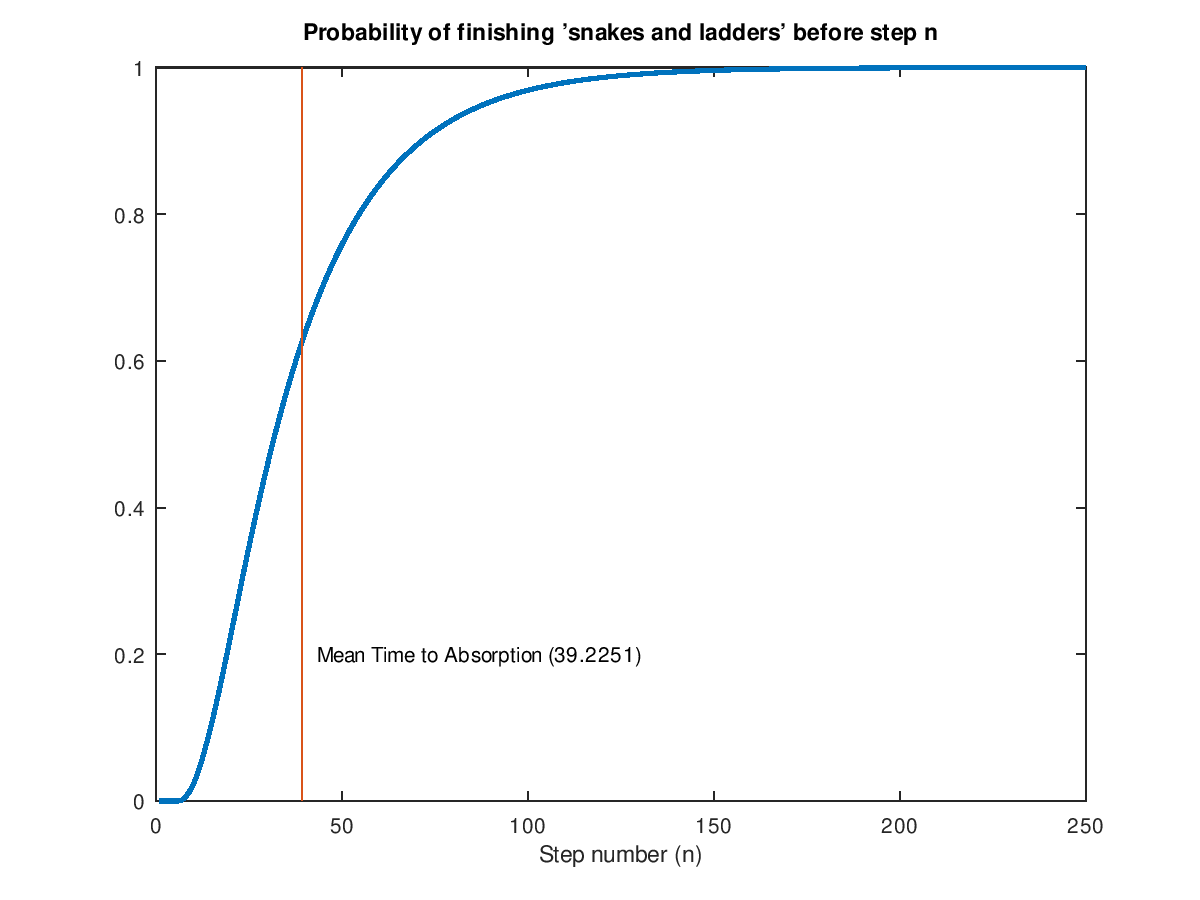- Function File: [t N B] = dtmcmtta (P)
- Function File: [t N B] = dtmcmtta (P, p0)
-
Compute the expected number of steps before absorption for a DTMC with state space {1, …, N} and transition probability matrix P.
INPUTS
P(i,j)N \times N transition probability matrix.
P(i,j)is the transition probability from state i to state j.p0(i)Initial state occupancy probabilities (vector of length N).
OUTPUTS
tt(i)When called with a single argument, t is a vector of length N such that
t(i)is the expected number of steps before being absorbed in any absorbing state, starting from state i; if i is absorbing,t(i) = 0. When called with two arguments, t is a scalar, and represents the expected number of steps before absorption, starting from the initial state occupancy probability p0.N(i)N(i,j)When called with a single argument, N is the N \times N fundamental matrix for P.
N(i,j)is the expected number of visits to transient state j before absorption, if the system started in transient state i. The initial state is counted if i = j. When called with two arguments, N is a vector of length N such thatN(j)is the expected number of visits to transient state j before absorption, given initial state occupancy probability P0.B(i)B(i,j)When called with a single argument, B is a N \times N matrix where
B(i,j)is the probability of being absorbed in state j, starting from transient state i; if j is not absorbing,B(i,j) = 0; if i is absorbing,B(i,i) = 1andB(i,j) = 0for all i \neq j. When called with two arguments, B is a vector of length N whereB(j)is the probability of being absorbed in state j, given initial state occupancy probabilities p0.
REFERENCES
- Grinstead, Charles M.; Snell, J. Laurie (July 1997). Introduction to Probability, Ch. 11: Markov Chains. American Mathematical Society. ISBN 978-0821807491.
See also: ctmcmtta.
Demonstration 1
The following code
n = 6;
P = zeros(101,101);
for j=0:(100-n)
i=1:n;
P(1+j,1+j+i) = 1/n;
endfor
for j=(101-n):100
P(1+j,1+j) = (n-100+j)/n;
endfor
for j=(101-n):100
i=1:(100-j);
P(1+j,1+j+i) = 1/n;
endfor
Pstar = P;
## setup snakes and ladders
SL = [1 38; ...
4 14; ...
9 31; ...
16 6; ...
21 42; ...
28 84; ...
36 44; ...
47 26; ...
49 11; ...
51 67; ...
56 53; ...
62 19; ...
64 60; ...
71 91; ...
80 100; ...
87 24; ...
93 73; ...
95 75; ...
98 78 ];
for ii=1:rows(SL);
i = SL(ii,1);
j = SL(ii,2);
Pstar(1+i,:) = 0;
for k=0:100
if ( k != i )
Pstar(1+k,1+j) = P(1+k,1+j) + P(1+k,1+i);
endif
endfor
Pstar(:,1+i) = 0;
endfor
Pstar += diag( 1-sum(Pstar,2) );
# spy(Pstar); pause
nsteps = 250; # number of steps
Pfinish = zeros(1,nsteps); # Pfinish(i) = probability of finishing after step i
pstart = zeros(1,101); pstart(1) = 1; pn = pstart;
for i=1:nsteps
pn = pn*Pstar;
Pfinish(i) = pn(101); # state 101 is the ending (absorbing) state
endfor
f = dtmcmtta(Pstar,pstart);
printf("Average number of steps to complete 'snakes and ladders': %f\n", f );
plot(Pfinish,"linewidth",2);
line([f,f],[0,1]);
text(f*1.1,0.2,["Mean Time to Absorption (" num2str(f) ")"]);
xlabel("Step number (n)");
title("Probability of finishing 'snakes and ladders' before step n");
Produces the following output
Average number of steps to complete 'snakes and ladders': 39.225122
and the following figure
| Figure 1 |
|---|
 |
Package: queueing